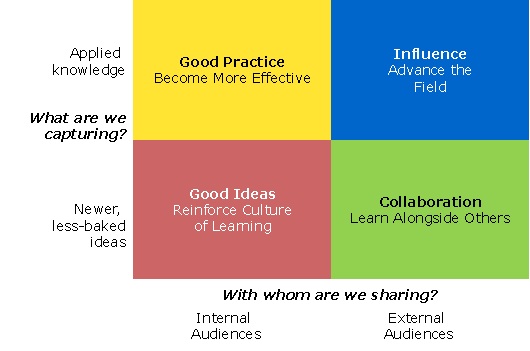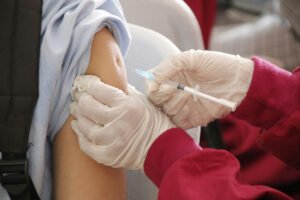
Henry Ford once observed, “Anyone who keeps learning stays young.” This is as true for organizations as it is for people. Since we began researching and writing about the challenges nonprofits face to make the most of organizational learning, we have heard from hundreds of social sector leaders on why and how they are circulating knowledge to rejuvenate their organizations and their fields. In a series of focus groups with nonprofit practitioners1 and foundations, we found that participants were zeroing in on two questions:
- What knowledge is useful to capture?
- With whom will we share what we learn?
The matrix below, which came out of those focus groups, shows four goals that map to these dimensions: sparking good ideas (fostering a culture of learning); sharing good practices (greater impact, more effectively); collaborating (learning alongside other organizations); or influencing your field to multiply impact. At any given time an organization may be driving toward a number of these goals. Indeed, all organizations stand to benefit from internal knowledge, surfacing good ideas and sharing good practices. Some organizations also fulfill their missions by engaging with external audiences to collaborate across their fields or to advance learning as a whole.
Figure 1. Learning Goals for Increasing Impact

Regardless of your goals, the next question is how to proceed. Will technology be your indispensible partner from the get-go? Or do you need to lead with old-fashioned people-to-people interactions? In the end, technology is only a platform and knowledge is most memorable when transmitted from one person to another. We’ll look at effective blends of people and technology processes to achieve each of the four goals. While they all require a mix of approaches, two goals—idea generation and collaboration—lead with people, while technology often comes first to support good practices and external influence.
Good Ideas: Building a Culture of Ideas and Learning
Where do good ideas in an organization come from? Typically from individuals or small teams tackling ongoing or newly encountered challenges. This happens inevitably across all organizations at some points, but organizations focused on learning equip their members to recognize good ideas and surface them for others to adapt and apply. That is, these organizations create processes that build and shape a culture of ideas.
Jumpstart, which aims to develop the cognitive skills of preschoolers in low-income neighborhoods, puts a premium on learning from the experiences of its corps of 3,200 college students. The corps members bubble up approaches that work, then share them in weekly phone calls and meetings. While it uses technology to archive good ideas in an electronic reference binder—available across program sites in 14 states and the District of Columbia—Jumpstart’s leaders recognize that the best way to make new ideas stick is person-to-person interaction.
This interaction often takes the form of experiential learning. Consider how Meredith, an Emmanuel College student and Jumpstart corps member, uses role-playing in her debrief with other corps members after mentoring 3- and 4-year-olds. She holds up a picture book, “Do you know what this book is about?” “Crocodiles!” shouts a fellow volunteer. With Post-its on each page as prompts, Meredith demonstrates how she uses the book with her kids. “We have the corps members mirror their approaches back to each other,” says Paul Leech, Jumpstart’s COO. “And then the listeners go around and give the demonstrator one “pro” and one “con” of the approach, so all learn from each other.” For Jumpstart, this culture of generating and sharing ideas is fundamental.
Good Practice: Becoming More Effective
What if a really powerful idea emerged from that Jumpstart debrief, something that ought to be shared beyond that little circle of corps members in the room or those who join the weekly call? For any organization that cares about becoming more effective, the face-to-face interaction—whether it’s a meeting, a phone call, or a casual water cooler chat—shouldn’t be the only way it shares good practices. It leaves out team members who may need the very same information but who are working remotely, or spread across sites, states, or even different countries.
Sometimes a practice we want to share constitutes a breakthrough—something proven, such as a new way to engage communities in preventing disease. Much of the time, however, we gain efficiencies by sharing practices with a “smaller p”—ways to work smarter, to ensure that everyone related to a program is up to speed on measures and results, such that it’s clear where to invest time in what works.
The challenge is to implement user-friendly technology where all staff can post good ideas and practices, breakthrough or “small p,” and to build in incentives for people to make the platform—whether a relatively inexpensive off-the-shelf application for smaller organizations, or a customized intranet for larger—part of their daily routine. In the case of Jumpstart, in 2013, the organization plans to pilot a system called “My Jumpstart,” which aims to create an electronic forum for corps members to share ideas in real time.
Or consider ClimateWorks Foundation, a $165 million grantmaker that funds advocacy to address climate change. The organization puts its intranet in the service of addressing this challenge. Over a three-month period, all administrative and operational staff began sharing project updates on the intranet, allowing other team members to stay current with developments without resorting to one-on-one communications. In addition to the user-friendly design of the system (which staff helped to shape), several clear incentives emerged for using the intranet to post updates.
First, the intranet allowed the operations staff, traditionally an office-bound group, to have more freedom to work outside the office. Now they could telecommute on a rotating basis and still work together effectively using a virtual office. Moreover, staff in real time could share project updates with their managers, who are often out of the office, without requiring face-to-face meetings. The efficiency gains from this new process created the biggest incentive for people to use it, says Sarah Nichols, ClimateWorks’ director of knowledge management. “Within a few months, the operations and admin team reduced its e-mail traffic by 37 percent and, due to the system’s transparency of workflow, check-in meeting time had been halved.” Less time spent on internal communications meant more time for applying learning to the organization’s goals.
Collaboration: Learning Alongside Others
Once your organization has developed processes for collecting and sharing internal knowledge, it’s not a great leap to open up some of your organization’s ideas and insights to others who can learn alongside you and prod you further.
Here, personal interaction typically takes the front burner to convert field challenges into lines of inquiry and emerging answers. Technology then follows to aggregate these points of view.
For example, the Pacific Northwest Association of Independent Schools (PNAIS) was seeking to develop a tool to help boards and heads of its 109 affiliated schools reflect on and strengthen core areas needed for accreditation. Executive Director Meade Thayer formed a working group of two staff members and eight heads of member schools, which met between 15 and 20 times over two-and-a-half years, reviewing outside materials, asking each other questions, and sharing experience to create a study guide. “[Working group members] represented different types of schools within our membership,” says Thayer. “The process was strongest where we asked the ‘right’ questions to cause greater reflection.”
Those questions became clear through agreement on the pain points related to 14 goals for a PNAIS school, which ranged from school culture and commitment, to diversity, to enrollment management and health and safety. Focusing on where it hurt gave direction to where to look for solutions and how to develop the right questions to help all schools. In the case of diversity, for example, the working group challenged schools to first define diversity within their context. What was the racial and ethnic makeup of the community they served? What professional development opportunities did faculty and staff have related to diversity? Ultimately, the group agreed on standards and indicators for each of 14 goals that could help schools assess just how close they were to each. This collaborative process yielded a learning tool—a downloadable self-study manual for boards, heads of schools, and faculty/staff to assess their performance on indicators for accreditation.
Equally important, it surfaced processes, like ensuring PNAIS professional development conferences included components that reinforce the new standards/expectations for PNAIS schools. And it established a model for working groups and built relationships that greased the wheels for ad hoc collaboration. Adds Thayer, “We had a new head of a school who was struggling with student safety. He sent out an SOS to the other heads and by the end of the day he had 20 pieces of advice from other heads of schools.”
Sign up for our free newsletters
Subscribe to NPQ's newsletters to have our top stories delivered directly to your inbox.
By signing up, you agree to our privacy policy and terms of use, and to receive messages from NPQ and our partners.
Funders, too, can collaborate on learning agendas—in this case, with grantees. While the specifics of the approach vary, the best learning agendas surface high-priority questions from foundation staff—say, program officers—as well as grantees. Getting to answers relies on active participation from both parties; in some cases, foundation staff may take on the role of bringing in perspectives from field experts to supplement grantees’ own knowledge and experience.
As in the PNAIS example, finding ways to share answers and recommendations is as vital as getting the questions right. Indeed, the recent Grantmakers for Effective Organizations report, “Learn and Let Learn,” highlights the importance of fluid structure in advancing a shared learning agenda in a group where participants and participation at any given moment may vary:
“One way to address participant ebb and flow is to provide a variety of learning structures— some mandatory and some optional—that cater to different learning needs and preferences, such as a combination of face-to-face and virtual meetings, real-time and offline interaction, action learning projects, site visits, and training sessions.”
Influence: Advancing the Field
Once you effectively learn alongside peers, it’s a natural step to share what you’ve learned externally to help advance the field (something we are trying to do with this article). For instance, the Acumen Fund, an organization that has invested more than $50 million in social entrepreneurs and emerging leaders over a decade and prides itself on a strong culture of generating and sharing ideas internally, recently decided to go a step further and make much of its internal knowledge public. “There was demand amongst our network to hear what we were working on, and we decided that, with few exceptions, there wasn’t any reason not to share,” explains Rob Katz, former portfolio manager and knowledge lead at Acumen. In this instance, the Internet provided a dissemination solution.
“Our biweekly Seen & Heard blog is essentially democratizing and syndicating what the Acumen Fund team is talking about and debating around this ‘virtual water cooler’,” Katz continues. “It sparks fuller conversations with our network of entrepreneurs, supporters, and peers, and allows them to see what we’re thinking about and weigh in with their thoughts.” At the same time, Acumen thought leaders are attending conferences and directly getting the word out to groups—pointing them back to the blog.
Or take a direct service example, one that seeks to advance the fields of public health, community development, and the environment concurrently and is using national media to broadcast good practice—person-to-people. Across the country, increasing numbers of nonprofit community health centers are opening facilities on brownfield sites, which qualify for government tax credits and grants to get cleaned up before they are used. This promising trend—all the more promising, given the predicted growth in such health centers under the Affordable Care Act—has been fueled by knowledge-sharing and communication efforts of health center leaders, environmental advocates, and local government officials who can articulate the benefits of this approach. Equally important, these parties have pooled their collective knowledge on the various streams of funding and stakeholders required to turn a brownfield into a budding health center. Michael R. Goldstein, an environmental lawyer in Florida, tells the New York Times, “We are just at the beginning of the journey here. I predict that in the next two years we’ll have close to two dozen [centers] across the state.” In such movements, mainstream media amplifies people-to-people sharing, creating tremendous reach. Testimonials of local nonprofit leaders like P. David Bohnam, COO of Tampa Family Health Centers, are wielding influence across the field. He told the Times: “[This site] was the ideal location for us in so many respects. We simply knew that we had the need here.”2
Together, technology—including mainstream media—and direct people-to-people interaction can nurture a cycle of learning and sharing that multiplies an organization’s impact in the world—whether that impact is achieved by sparking good ideas, improving day-to-day practice, collaborating to achieve an end, or influencing an entire field or sector. Getting the right combination of technology-powered and people-powered processes depends on understanding the particular strengths and limits of each, and matching those characteristics to what you intend to achieve.
|
Do’s and Don’ts of Learning Goals Good Ideas
Good Practice
Collaboration/Learning Alongside Others
Influence/Advancing the Field
|
Katie Smith Milway is a partner with The Bridgespan Group and heads the organization’s Knowledge Unit. Ann Goggins Gregory is Bridgespan’s senior director of internal knowledge.
- Focus groups included discussion tables and report outs with more than 200 nonprofit and foundation attendees at the 2011 Stanford Institute of Nonprofit Management. Authors tested findings through 2012 in one-off sessions with select nonprofits and funders.
- Ronda Kaysen, “Health Centers Find Opportunity in Brownfields,” the New York Times, December 11, 2012; Ruth McCambridge, “Innovative Double Whammy: Developing Health Centers on Brownfields,” NPQ Newswire, January 4, 2013








